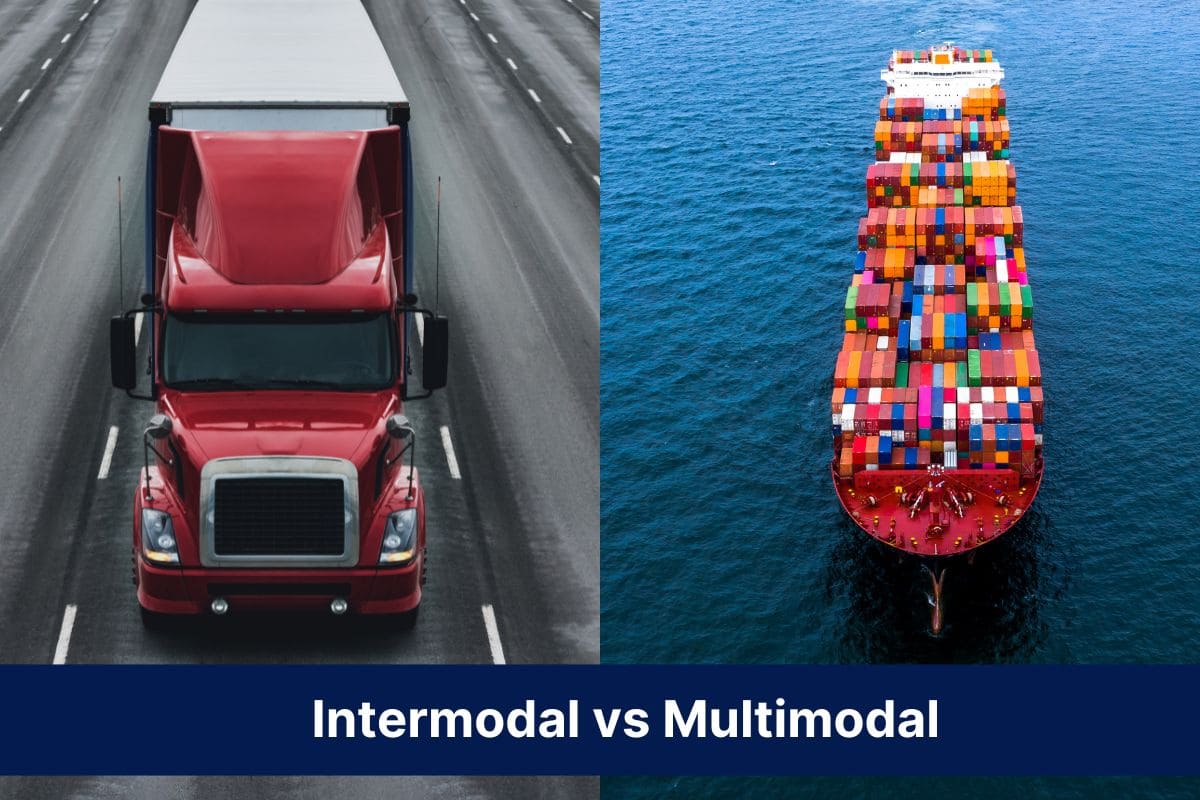Key Takeaways
Multimodal and intermodal transportation describe how goods move using more than one mode of transport to reach their final destination. The main difference is the number of contracts you sign.
- Intermodal means you work with separate carriers for each part of the trip.
- Multimodal means you use one carrier and one contract for the full journey.
Choose intermodal if you want more control and better rate options.
Choose multimodal if you want a simple process with less coordination.
Both systems move freight across various modes of transport such as truck, rail, and sea to reach the final destination.
The choice depends on how much time you can spend managing the shipment.
What is intermodal transportation?
Intermodal transportation uses different transport modes, such as truck, rail, and sea, to move goods from start to finish. The cargo stays in one container the whole way. Only the vehicles change.
Each part of the trip is managed by a different carrier. The shipper signs separate contracts for each mode, and every carrier is responsible for its own leg. Each section also has its own bill of lading, which helps track the shipment along the way.
For example, a shipment may start at a factory in China and end at a warehouse in the US. A truck carries the container to the port, where it’s loaded onto a cargo ship bound for America. Once it arrives, a railway company moves it inland before another truck delivers it to the final destination. The same sealed container is used for the entire trip, keeping the goods protected and transfers quick.
Intermodal transport can save money on long routes. Using rail or sea freight for most of the distance cuts fuel costs and emissions. It’s a good choice for shippers who want lower rates and flexibility in selecting their transport carrier.
What is multimodal transportation?
Multimodal transportation is a method of moving goods using two or more transport modes under one contract. One company, called a multimodal transport operator (MTO), oversees the entire multimodal freight journey, taking responsibility from pickup to delivery.
You only deal with a single carrier, even when your cargo moves across truck, rail, and sea routes. The MTO coordinates all carriers, manages customs documents, and tracks the shipment the whole way. A single multimodal bill of lading covers the full trip, making it easier to manage and trace.
This system streamlines the entire transportation process and reduces paperwork for shippers. It also lowers the risk of delay since one team oversees all modes of transport. While it can cost more because the MTO charges a service fee, many businesses find the smoother process worth the added cost.
What is the difference between intermodal and multimodal transport?
| Factor | Intermodal Transport | Multimodal Transport |
| Contracts | Several contracts with different carriers | One contract for the entire trip |
| Liability | Shared among carriers | Managed by one Multimodal Transport Operator (MTO) |
| Who You Talk To | Multiple companies or agents | One main contact for all modes |
| Coordination Load | Higher, since each stage is handled separately | Lower, as one operator manages everything |
| Best For | Companies with logistics experience and strong carrier networks | Businesses that want simple door-to-door delivery |
Advantages of Intermodal shipping
Intermodal transport links separate carriers across modes through individual contracts. It’s often used by companies that want to compare costs, choose preferred routes, and adapt quickly when conditions change.
1. More Control and Flexibility
You can choose specific carriers for each route based on cost, reliability, or timing. This setup lets you customize routes and switch transport modes when needed.
2. Cost Savings on Long Distances
Rail and sea transport are cheaper and more fuel-efficient than road freight. Using them for longer legs of the trip helps cut fuel costs and reduce overall spending.
3. Lower Risk of Damage
Cargo stays in one sealed container from start to finish. Less handling means fewer chances of damage, loss, or delays.
4. Easier Route Optimization
With separate carriers, you can plan routes that best match your delivery schedule and cargo type. If one route faces congestion, you can quickly redirect through another mode.
Advantages of Multimodal Shipping

Multimodal transport simplifies complex routes by combining all transport modes under one point of contact. This helps logistics teams save time on coordination, avoid duplicate paperwork, and focus on delivery schedules instead of managing separate carriers.
1. One Contract, Less Admin
You only work with one carrier for the entire route. This reduces paperwork and coordination across multiple providers.
2. Faster Customs and Documentation
A single contract (bill of lading) covers every leg of the trip. Customs clearance is faster, and your logistics team spends less time managing separate documents.
3. Shorter Transit Time
The MTO plans routes across all transport modes. They can adjust schedules to avoid congestion and improve delivery time.
4. Simpler Communication
With one operator, you always know who to contact for shipment updates. This reduces errors and improves accountability.
When Multimodal Works Best
| Situation | Key Advantage |
| Door-to-door delivery | One operator manages all stages |
| Cross-border freight | Faster customs and route planning |
| Limited logistics staff | Less coordination needed |
How to Choose: A 5-Step Checklist for Shippers
Choosing between intermodal and multimodal transportation starts with understanding your shipment needs. Follow these five simple steps before signing any contract.
Step 1: Map your shipment route
List each leg of your cargo’s journey. If you already use two or more modes like truck + rail or sea + road, note where handovers happen.
If your route crosses several borders or ports, multimodal simplifies customs and documents.
Step 2: Assess your coordination capacity
Ask who manages bookings and paperwork.
If your team can handle multiple carrier contracts, intermodal offers better rate control. If not, choose multimodal for a single point of contact.
Step 3: Review the documentation type
Check what bill of lading you receive.
Multimodal uses one combined bill of lading (issued by an MTO). Intermodal issues one per mode. Choose based on how much document tracking your team can handle.
Step 4: Compare timing and risk
Estimate how long handovers add to your delivery time.
Intermodal gives flexibility but adds transfer points and potential delays. Multimodal removes those handovers, ideal for time-critical freight.
Step 5: Balance cost with simplicity
Get quotes from both options.
Intermodal often saves 10-15 % on long routes but requires more admin. Multimodal may cost slightly more, yet it reduces management time and customs delays.
Example of Freight Transportation in Intermodal and Multimodal Shipping
When Intermodal Transportation is the better choice
An Australian exporter sends grain from Perth to Singapore using rail, port, and sea. Each leg is handled by a separate transport carrier, allowing the exporter to negotiate better local rates. When a rail strike delayed departures, they quickly switched to a third-party logistics operator to move containers by truck to the port. This intermodal transportation method gave flexibility to change carriers and routes, cutting total shipping cost by 12%. It shows how intermodal freight provides better cost control and adaptability across different modes of transportation.
When Multimodal Transportation is the better choice
A manufacturer in Thailand ships medical equipment to hospitals in France. The journey involves sea freight to Rotterdam, rail to Paris, and truck delivery to regional facilities.
By using multimodal transportation, one logistics provider managed all transport modes under a single contract. The combined bill of lading simplified customs at each terminal and reduced handover delays. The shipment arrived three days earlier than under the previous intermodal setup, showing how multimodal transport reduces coordination time and streamlines international deliveries.
Common Mistakes Shippers Make
Even experienced businesses can make small errors that lead to delays or extra costs. Here are key pitfalls to avoid:
Documentation Errors
Using the wrong bill of lading or mismatched cargo details can trigger customs or insurance problems. Multimodal shipments need one combined bill of lading, while intermodal shipments use separate ones. Always confirm that every document lists the same weights, HS codes, and packaging details before departure.
Poor Planning for Transfers and Storage
Containers often sit idle between ports, rail yards, and warehouses because short transfers, known as drayage, aren’t arranged on time. These delays can lead to detention and demurrage fees when containers exceed their free storage period. Plan every leg of the journey, including local moves, to keep containers flowing through terminals and avoid extra charges.
Gaps in Insurance Cover
Some carriers only insure their own leg of the journey. If cargo is damaged during transfer, it may fall outside their policy. Review your insurance to confirm it applies across all modes and handovers in the transport chain.
Use IncoDocs to Make Compliant Documentation
Accurate documentation keeps international shipments moving without delay. IncoDocs helps businesses create and manage transport documents for both intermodal and multimodal shipments in one place.
You can generate the right bill of lading, share documents with freight partners, and ensure every detail matches across carriers and transport modes. The platform also helps teams track shipment records, reduce manual data entry, and stay compliant with customs and insurance requirements.
With IncoDocs, shippers spend less time chasing paperwork and more time managing the actual movement of goods from origin to destination.







